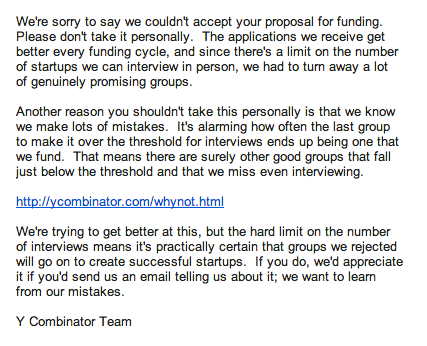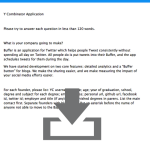When Buffer was in its very early stages, just a couple months after the product launched, we applied to be part of the prestigious Y Combinator accelerator program.
We were rejected.
Since then, we’ve been keenly aware that this experience is one that many fellow startups have encountered and one that many more will eventually face. When Karen Cheng, CEO of GiveIt100, shared the story of her Y Combinator rejection, it struck a chord with readers. Rejection stories don’t get told nearly often enough, which is why we wanted to share ours.
Like so many other startups, we viewed Y Combinator as the ultimate accelerator program, and we were eager to apply. Looking back on our application now (the full text of which appears below), it’s humbling to see how far we’ve come—and a little embarrassing to see some of our answers. For instance, we gladly shared our monthly revenue on our application—$280 per month from 45 paying customers. I wonder what the Y Combinator panel thought of that!
Incubators like Y Combinator are looking for world-changing ideas, star-studded teams, or real-world traction. At the time, our fit here just wasn’t right. But we did get a really nice rejection letter. Here’s what Y Combinator sent us:

Applying for this opportunity was extremely exciting for both me and Leo, but we had already committed to a great product regardless of the outcome with Y Combinator. We understood that accelerator programs and funding were not going to make our product great; our success was tied to our effort and ideas.
Our journey eventually did include an incubator; we were accepted into Angelpad in August of 2011. As we kept applying for opportunities like these, we finally reached an inflection point where our product fit with the vision and goals of an incubator. If you find yourself in a similar position, I’d encourage you to keep applying.
And if there are any lessons you could learn from a rejected Y Combinator application, I’d be happy for you to learn from ours. See our application below, and view it as a pdf.
Do you have a rejection story to share? I’d love to hear about your journey in the comments.

Buffer’s Y Combinator Application
What is your company going to make?
Buffer is an application for Twitter which helps people Tweet consistently without spending all day on Twitter. All people do is put tweets into their Buffer, and the app schedules tweets for them during the day.
We have started development on two core features: detailed analytics and a “Buffer button” for blogs. We make the sharing easier, and we make measuring the impact of your social media efforts easier.
Please tell us in one or two sentences about the most impressive thing other than this startup that each founder has built or achieved.
Joel: After graduating I founded a startup rather than getting a job. It reached 6,000 users and gave me the first real lessons of building a startup. The many mistakes contributed to how I approached Buffer.
Leo: I offered the Business School to build a better feedback system and although they agreed to it beforehand, I was threatened to be kicked out after pushing an MVP live as sharing data in such an interactive way for students, was not acceptable.
Please tell us about the time you, Joelg87, most successfully hacked some (non-computer) system to your advantage.
I applied the 80/20 principle at University. There was an option where you could gain extra credit by doing more than the recommended load of work. I took Japanese as my extra class, and 3 of my 4 years it enabled me to finish with a mark of 76% although I averaged 70% in my classes.
Please tell us about an interesting project, preferably outside of class or work, that two or more of you created together. Include urls if possible.
There are no shared projects before Buffer.
How long have the founders known one another and how did you meet? Have any of the founders not met in person?
We met about 2 years ago at an entrepreneurs networking event and have bounced ideas off each other ever since.
Why did you pick this idea to work on? Do you have domain expertise in this area? How do you know people need what you’re making?
– I wanted to solve my own problem and was frustrated with how other tools approached scheduling tweets.
– Leo created a small company providing a learning centre for newcomers to Twitter in Austria.
– We have 44 people paying for Buffer on a monthly subscription.
What’s new about what you’re making? What substitutes do people resort to because it doesn’t exist yet (or they don’t know about it)?
– Buffer erases two steps twitter users usually had to take to schedule tweets. The first one being setting the time of each individual tweet. The second one being to go to your account in Tweetdeck or Hootsuite in order to schedule from there. With Buffer all you do is hit the Buffer icon on the page you are reading to add more tweets.
– If users are currently not using Buffer, they would be using “normal tweet scheduling”, such as SocialOomph, Hootsuite, Tweetdeck or any of the other about 10 similar services out there.
Who are your competitors, and who might become competitors? Who do you fear most?
– At the moment our competitors are the applications named above. In addition there are 3 more application, which are more closer to the nature of Buffer. They are Timely, Pluggio and 14blocks.
– Losing our focus on what the customer needs and focusing on whom we fear most is what we fear most.
What do you understand about your business that other companies in it just don’t get?
One of our users sent us this: “I really appreciate the “human” quality of your company. We try for that in our own company too for the exact reason that those are the kinds of companies we like to deal with ourselves.”
We understand making customers happy is the most important thing.
How do or will you make money? How much could you make? (We realize you can’t know precisely, but give your best estimate.)
– We are making $280/mo
– We have a consistent conversion rate from free to paid plans of 4%
– We have a strong acquisition engine through planned referral and affiliate programmes
– We have been focused on building a great product and have not give much thought to how much we could make. At current growth rate, a monthly income in the tens of thousands of dollars seems very achievable.
If you’ve already started working on it, how long have you been working and how many lines of code (if applicable) have you written?
We have been working on Buffer since October 2010. We have a fully functioning product which we are shouting about.
If you’re launched, what is your monthly growth rate (in users or revenue or both)?We have 1500 users at the moment, of which 45 are paying. This gives us a monthly revenue of $280. Numbers of users is growing at 400% per month. Here is a chart:
If you have an online demo, what’s the url? (Please don’t password protect it; just use an obscure url.)
How will you get users? If your idea is the type that faces a chicken-and-egg problem in the sense that it won’t be attractive to users till it has a lot of users (e.g. a marketplace, a dating site, an ad network), how will you overcome that?
We have 3 main sources to get users:
– Via blogposts (we write a lot of reviews about our own product and submit them for guestposting or ask for being reviewed)
– Planned referral programme
– Planned affiliate programme
If you’re already incorporated, when were you? Who are the shareholders and what percent does each own? If you’ve had funding, how much, at what valuation(s)?
– We are not yet incorporated.
– We have had no funding.
If you’re not incorporated yet, please list the percent of the company you plan to give each founder, and anyone else you plan to give stock to. (This question is as much for you as us.)
– Joel founded Buffer in October, and Leo came on board in January. Leo will have 30% over a 3 year period. We would like some advice on this.
If we fund you, which of the founders will commit to working exclusively (no school, no other jobs) on this project for the next year?
Both
Do any founders have other commitments between June and August 2011 inclusive?
Leo will finish his exams at beginning of June.
Do any founders have commitments in the future (e.g. finishing college, going to grad school), and if so what?
Leo is having a year out from University to work on Buffer until Summer of 2012. Continuation thereafter is optional.
Where do you live now, and where would the company be based after YC?
We both live in the UK, Birmingham at the moment. We plan on moving the company to the US, Silicon Valley after YC.
Please tell us something surprising or amusing that one of you has discovered. (The answer need not be related to your project.)
We managed to create a DoS attack on ourselves. We have a Chrome extension which lets people add tweets, and which shows people how many tweets are left in their Buffer too. To show the number, the extension polled the server every 5 seconds. After a few hundred people installed the extension, we found the server almost came to a halt. After some investigation, we thought we were under attack and even started banning some IPs, of our own users! Glad we weren’t!
***
(Image credit: Neal.)
Try Buffer for free
190,000+ creators, small businesses, and marketers use Buffer to grow their audiences every month.



